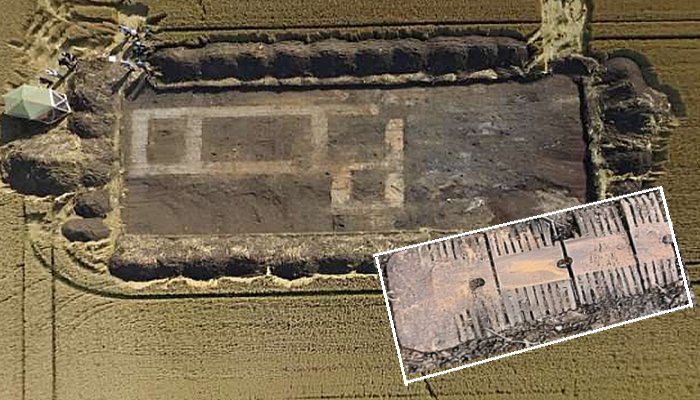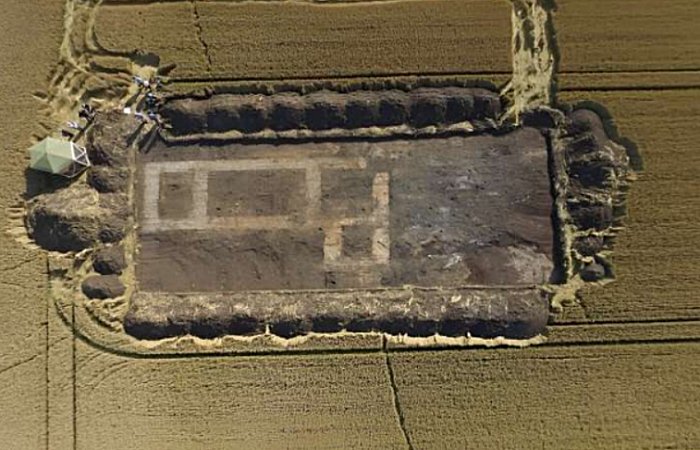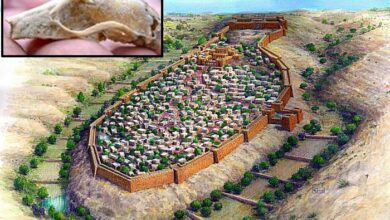Lincolnshire’s Prehistoric Henge And A Sacred Site Dating Back Hundreds Of Years

Conny Waters – AncientPages.com – The dig at a supposed early Medieval hermitage near Crowland, England, revealed a site with an extensive and intricate timeline.
Today, the remnants of a medieval abbey are the main feature of Crowland. Yet, local lore suggests that this place was once home to an Anglo-Saxon hermitage associated with Saint Guthlac.
An aerial view of the excavation site at Crowland. Photo: The Anchor Church Field Project
This revered saint, who passed away in 714, was known for his solitary lifestyle. He chose this path over a life of luxury he could have had as a nobleman’s son.
In Crowland, Lincolnshire, researchers from Newcastle University found signs of a sacred landscape that has been changing and developing over centuries.
Guthlac’s body was found untouched and preserved a year after his passing, he was deeply revered by his close-knit community. His popularity during his lifetime and the success of the cult and pilgrimage played a significant role in founding Crowland Abbey in the 10th century as a tribute to this saint.
We have limited historical records about Guthlac’s life, primarily from the Vita Sancti Guthlac (Life of Saint Guthlac), penned by a monk named Felix soon after his death. However, it’s generally accepted that Guthlac established his hermitage in a previously looted barrow or burial mound.
For years, attempts have been made to find its location, and although Anchor Church Field was generally considered the most probable location, the lack of thorough excavation combined with the escalating effects of farming activities in the vicinity have hindered a complete comprehension of the area.
The team, comprising experts from the University of Sheffield, also undertook an excavation at Anchor Church Field. Much to their astonishment, they unearthed a history far more intricate and ancient than what they had initially anticipated.
The first discovery they made was a previously unknown Late Neolithic or early Bronze Age henge, a type of circular earthwork and one of the largest ever discovered in eastern England.
Given its significant size and strategic location, the henge would have been a standout landmark in the area, serving as a key site for ceremonial events. Back then, Crowland was essentially a peninsula, bordered by water and marshes on three sides. The henge was positioned at an unmistakable and highly noticeable spot that jutted out into the Fens.
Later, it was abandoned for several centuries, but the significant prehistoric earthworks would have remained noticeable until the medieval era. This likely made it an attractive location for hermits like Guthlac who saw it as a distinct landscape with a rich and sacred history.
One of the bone combs discovered at Crowland. Photo: The Anchor Church Field project
The henge was once again inhabited during Guthlac’s era. The excavation team unearthed pottery, two bone combs, and shards of glass from a high-end drinking vessel. These artifacts shed light on the henge’s usage during the Anglo-Saxon period.
“We know that many prehistoric monuments were reused by the Anglo-Saxons, but to find a henge—especially one that was previously unknown—occupied in this way is really quite rare,” said Dr. Duncan Wright, Lecturer in Medieval Archaeology at Newcastle University, in a press release
“Although the Anglo-Saxon objects we found cannot be linked with Guthlac with any certainty, the use of the site around this time and later in the medieval period adds weight to the idea that Crowland was a sacred space at different times over millennia.”
The discovered features include remnants of a 12th-century hall and chapel, likely constructed by the Abbots of Crowland to honor the hermits residing here. The hall was probably designated for upscale lodging, likely accommodation for high-ranking pilgrims visiting Crowland.
See also:
More Anglo-Saxon Burials And Artifacts Found In Lincolnshire, UK
Large Anglo-Saxon Burial With Bodies And Roman Artifacts Found At Bicker Fen, Lincolnshire, UK
Directly in front of the hall and chapel, the archaeologists also found a one-meter stone-lined pit that was thought to be well when it was uncovered in the 19th century. The excavations revealed that the pit was rather a flagpost hole or, more likely, the setting for a large cross.
After the 12th century, the landscape surrounding Crowland changed much. The Anchor Church Field, once enveloped by water, found itself on arable land that could be cultivated and farmed. This change drastically altered the area’s topography.
Over time, the site lost its prestigious role. However, documents from the 18th century reveal that the cottage owner maintained his respect for the hermits. He would devoutly venture into his garden every Sunday to kneel and pray.
Dr. Hugh Willmott from the University of Sheffield said that the archaeological findings and historical texts clearly indicate that Anchor Church Field maintained its revered status even in later years.
He emphasized the significance of Guthlac and Pega, key figures in England’s early Christian history, making it exhilarating to establish a timeline for such an important historical site.
Paper: Sacred Landscapes and Deep Time: Mobility, Memory, and Monasticism on Crowland
You can find more about their findings in the Journal of Field Archaeology.
Written by Conny Waters – AncientPages.com Staff Writer






